

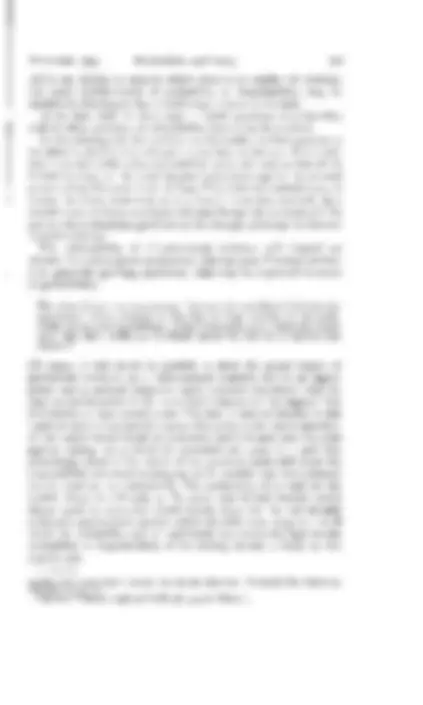
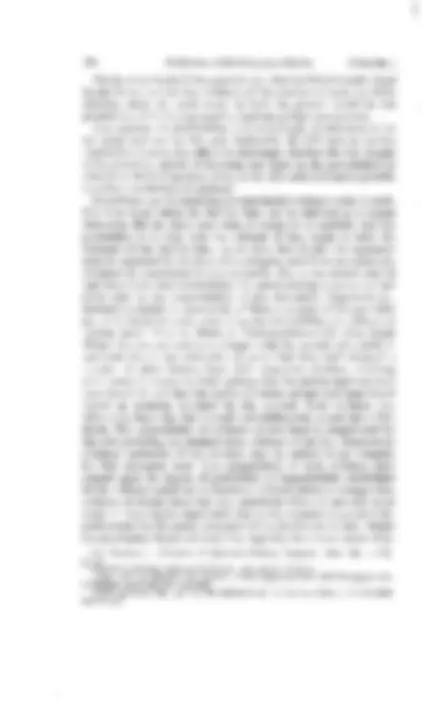
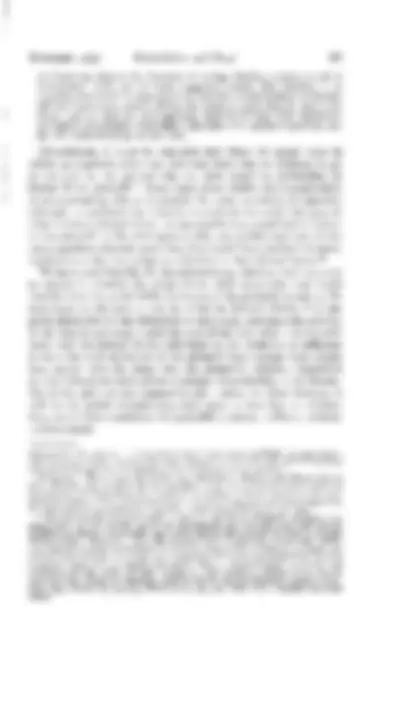



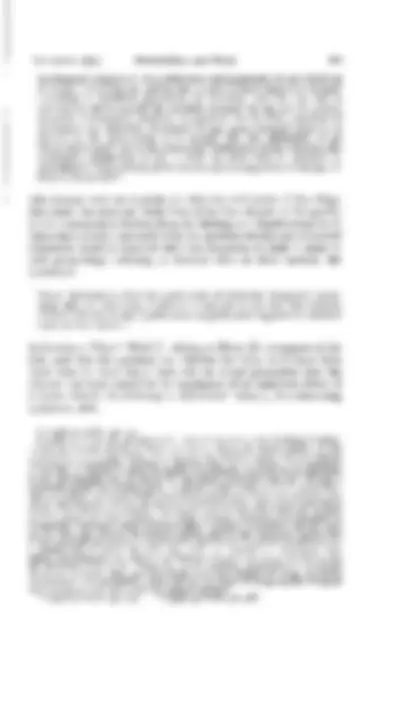
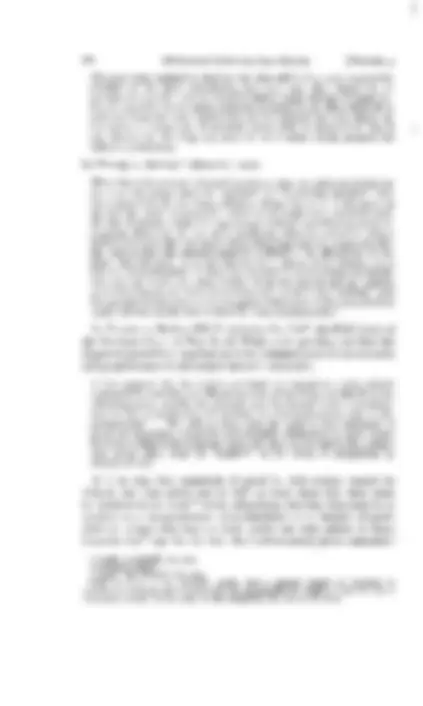
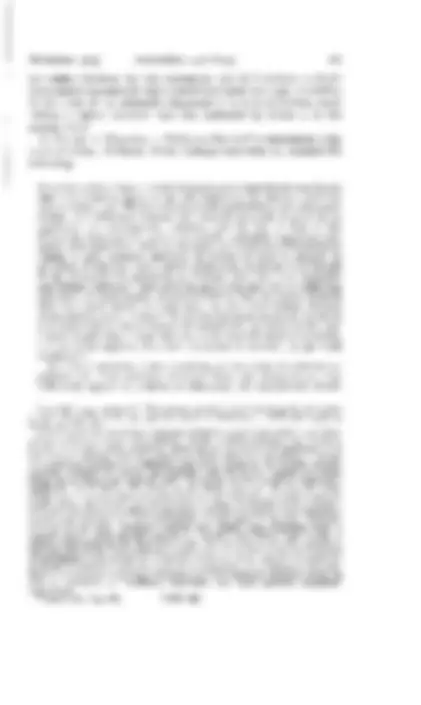
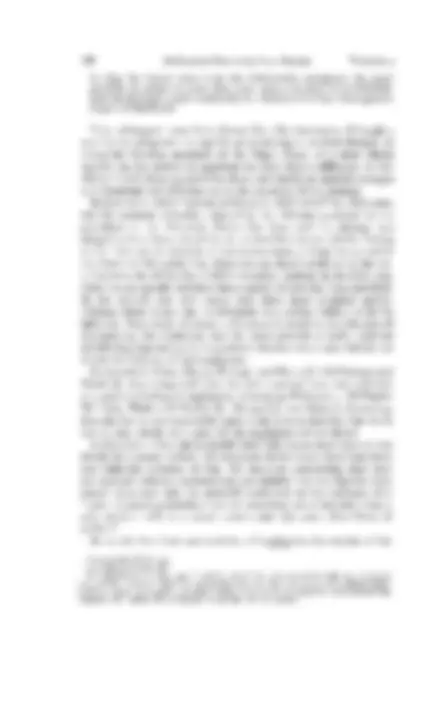

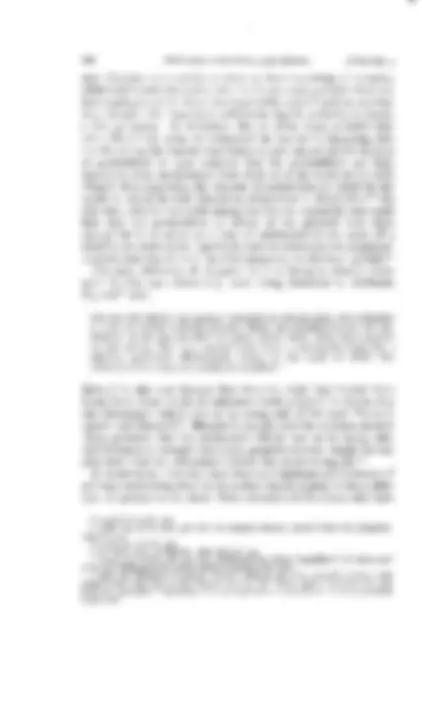


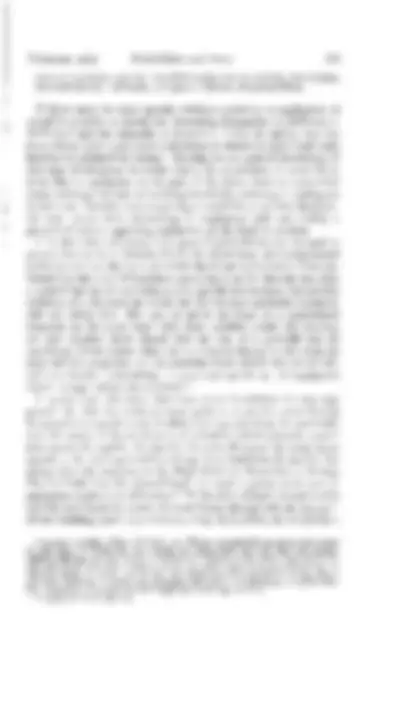

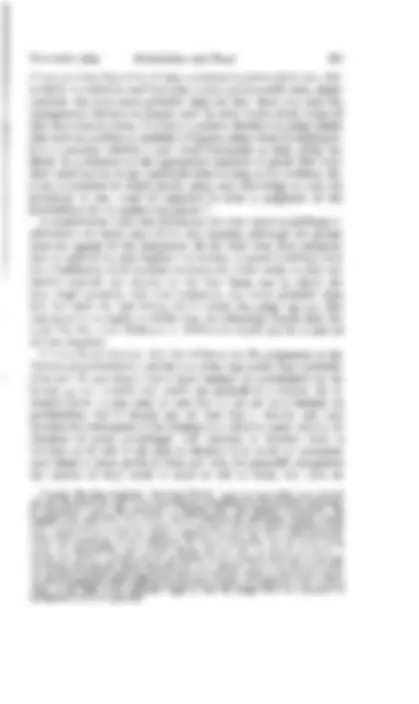

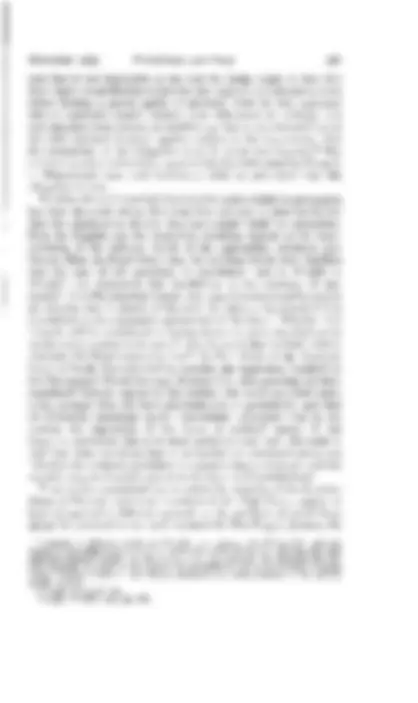

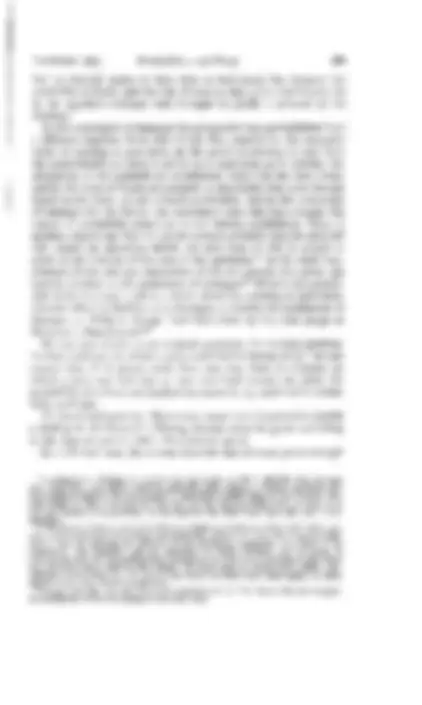

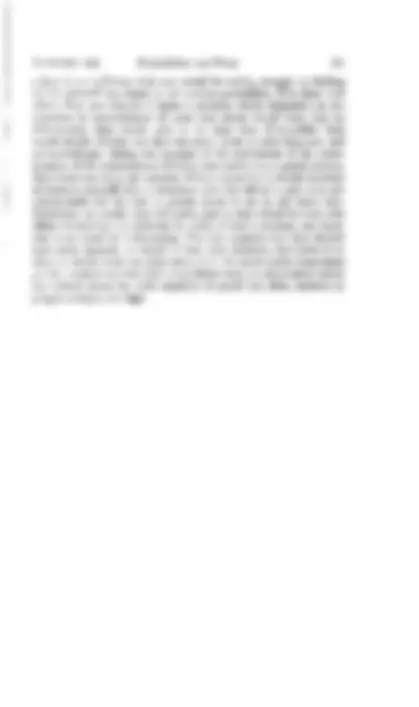


Study with the several resources on Docsity

Earn points by helping other students or get them with a premium plan


Prepare for your exams
Study with the several resources on Docsity

Earn points to download
Earn points by helping other students or get them with a premium plan
Community
Ask the community for help and clear up your study doubts
Discover the best universities in your country according to Docsity users
Free resources
Download our free guides on studying techniques, anxiety management strategies, and thesis advice from Docsity tutors
The role of probability in civil trials, focusing on the function of the jury in deciding facts and assessing damages. It explores the concept of reasonable satisfaction and the difference between civil and criminal cases in terms of the required degree of proof. The text also touches upon the admissibility of evidence and the importance of considering the seriousness of the allegations and the consequences of the findings.
Typology: Slides
1 / 32

This page cannot be seen from the preview
Don't miss anything!

























By THE HONOURABLE MR JUSTICE ECCLESTON*
If A proves that B has tossed a coin a certain number of times, the result of each toss being unknown to A, and the issue for the jury being whether anyone or more of the tosses resulted in a head, is there evidence on which a jury could find in favour of A? If so, how many tosses must be proved to justify a finding in A's favour? To questions of this kind, the law provides an answer only in general terms. Moreover, judges do not agree about the form in which the answer should be expressed. The purpose of this article is to examine the answers which have been given in order to see whether they can be reconciled with each other, and whether they are capable of being expressed in a form which does not admit of differing inter- pretations. In order to introduce the subject in lawyers' language, we may quote what was said by Denning L.J. (as he then was) in Bater v. Bater: 1
As Best C.]. and many other great judges have said, "in proportion as the crime is enormous, so ought the proof to be clear". So also in civil cases, the case may be proved by a preponderance of probability but there may be degrees of probability within that standard. The degree depends on the subject-matter.
Later in the same judgment His Lordship said:
So the phrase "reasonable doubt" takes the matter no further. It does
or as low as SI per cent. The degree required must depend on the mind of the reasonable and just man who is considering the particular
in others. When this is realized, the phrase "reasonable doubt" can be used just as aptly in a civil case or a divorce case as in a criminal case .... 2 We shall examine at a later stage how far this approach to the relationship of civil and criminal standards of proof represents the Australian position. We must first discuss the standards of probability involved in the concept of a range of probability between SI per centum and 99 per centum or, more completely, between 0 and 100 per centum.
Probabilities and Proof 181
Probabilities may be expressed as a percentage, as in the above passage, or as odds (ten to one on, or six to four against), or as a fraction or decimal, but however they are expressed they measure the proportion which favourable chances and unfavourable chances bear to each other or to the total number of chances involved. If a coin is tossed once, there is one chance of a head and one of a tail and these (in the absence of psycho-kinesis or of any peculiarity in the coin) are equal. The chances of a head may therefore be
two heads in two tosses are the product of the chances on each toss, and this can be calculated by the multiplication of the fraction or decimal expression of the probability. Thus the probability of getting two heads in two tosses is '5 x '5='25 or 25 per centum, and the odds against are three to one. There are, in fact, four available combina-
The probability of three successive heads is '5^3 and of N successive heads is ·SN. The notation of probabilities by fractions or decimals is the most convenient for calculation but other modes of expression are used hereafter where it seems more convenient to do so. In the frac- tional or decimal scale, the maximum probability, which is certainty (no unfavourable chances) is I, and the minimum, or impossibility (no favourable chances) is o. In order to enable the reader to test his own reactions to the ques- tions of probability posed from time to time in this article, it is con- venient to set out the probabilities of obtaining successive heads in any given number of tosses in the form of a table.
Number of tosses 234 5^6 7 8 9 10 1 1 1 1 1 1 1 1
12
2 4 8 16 32 64 128 256 512 1024 2048 4096
It will be realized that the probability of not getting any head is the same as that of getting all tails, and so the probability of one head turning up in a series of tosses is ascertained by deducting from I the probability of getting all tails, since the probabilities of all possible results must add up to I. In order to get a realistic picture of the probability of 51 per centum referred to by Lord Denning, we can imagine a bag containing 100 marbles, of which 51 are black and 49 are white. The probability of drawing a black marble in one draw is 51 per centum and of a white one 49 per centum. Sometimes the probabilities involved in determining an issue of fact in litigation can be expressed mathematically, but in the great
NOVEMBER 1963] Probabilities and Proof 183
ability in relation to cases in which there is no conflict of evidence, the same considerations of probability or improbability may be decisive in choosing between conflicting versions of the facts. As we have said, the first stage at which questions of probability arise is when questions of admissibility have to be determined. In determining whether evidence is admissible, the first question to be asked is whether it is relevant to any issue in the case. If it is rele- vant it is admissible unless excluded by some rule such as that which forbids hearsay, or the proof of prior convictions against an accused person whose character is not in issue. The evidence tendered may, of course, be direct testimony as to a fact in issue (for example, in a murder case, evidence of a bystander that he saw the accused stab the person whose death has given rise to the charge), or it may be 'circum- stantial evidence'. The admissibility of circumstantial evidence will depend on whether it tends to prove or disprove a fact in issue. If it does neither, it is, generally speaking, irrelevant. This may be expressed in terms of probabilities.
The class of acts and occurrences that may be considered includes cir- cumstances whose relation to the fact in issue consists in the prob- ability or increased probability, judged rationally upon common experi- ence, that they would not be found unless the fact to be proved also existed.^4
Of course, it will rarely be possible to show the actual degree of probability involved, as a mathematical quantity, but in an appro- priate case a rational judgment upon common experience may in- clude a consideration of the numerical chances. Let us suppose that B is known to have tossed a coin. The fact in issue is whether it was heads or tails. It is proposed to prove that prior to the toss in question, B had tossed eleven heads in succession and it is said that the odds against tossing twelve heads in succession are 4,095 to I, and that accordingly proof of the result of the previous tosses will show the improbability of a head turning up on the twelfth toss. The evidence would, however, be inadmissible. The probability of a head on the twelfth throw is still only '5. To prove that B had already tossed eleven heads in succession would merely show that he had already achieved a performance against which the odds were 2,047 to I, or of which the probability was '5 11 , and would not throw any light on the probability or improbability of his having thrown a head on the twelfth toss.
together they would have won the case for the Claimant: Woodruff, The Tichborne Claimant (1957) '7 (^) '. 4 Martin v. Osborne (1936) 55 C.L.R. 367, 375 per Dixon J.
184 Melbourne UnivCTsity Law Review [VOLUME 4 On the other hand, if the question was whether B had tossed a head in any throw on that day, evidence of the number of tosses would be relevant, since the more tosses he had, the greater would be the probability of his having tossed a head on at least one occasion. The question of admissibility, and accordingly of relevance, is for the judge and not for the jury. Ordinarily, he will have to use his experience of every day affairs to determine whether the fact sought to be proved is capable of throwing any light on the probabilities in relation to the facts in issue, since, as we have said, it is rarely possible to make a mathematical analysis. 5 Sometimes a party tendering circumstantial evidence seeks to estab- lish facts from which the fact in issue can be inferred as a logical deduction. But in other cases what is sought is to establish that the probability is so high that the tribunal of fact ought to infer the existence of the fact in issue. In the first class of case the argument may be expressed in the form of a syllogism, and if the premisses are accepted the conclusion follows inevitably. But in the second class of case there is no such inevitability; the party seeking to prove the fact relies only on the improbability of any alternative hypothesis put forward to explain the proved facts. 6 Many examples of this approach are to be found in cases concerning the admissibility of evidence of
was held that it was admissible to prove that they had 'adopted' a number of other infants from their respective mothers, receiving small sums of money for their upkeep, that the infants had not since been heard of, and that the bodies of eleven infants had been found buried in premises occupied by the accused. Such evidence was relevant to show that the accused had deliberately caused the child's death. The admissibility of evidence of this kind is complicated by the rule excluding, in criminal cases, evidence of the bad character or criminal tendencies of the accused, and the subject is too complex for full treatment here. The admissibility of such evidence may depend upon the degree of probability or improbability established by the evidence tendered. In Martin v. Osborne, Evatt J. thought that evidence of similar facts was only admissible where it was such as to render it 'very highly improbable that on the occasion in question the performance by the party concerned of the further act in issue would not accompany his proved acts',8 but logically there is no reason why, S Cf. Flannery v. Waterford & Limerick Railway Company [1877] I.R. II CL. 30 ,37.
7 [1894] A.C. 57. See also The Queen v. Grills (1956) 73 W.N. (N.S.W.) 303 (a case of repeated poisoning by thallium).
-case at 376.
186 Melbourne University Law Review [VOLUME 4 all the facts are peculiarly within the knowledge of the defence, al- though the plaintiffs are not absolved from the obligation of establish- ing a prima facie case, the doctrine of the scintilla is applied somewhat indulgently, and comparatively slight evidence may be regarded as calling for an explanation. 12
The fact that the truth of a party's allegation lies peculiarly within the knowledge of his opponent does not alter the burden of proof, but once a prima facie case has been made out, the failure of the defendant to give evidence in a case in which the facts are within his knowledge may increase the probabilities in favour of the inference which the plaintiff seeks to draw. 14 This principle applies equally to criminal cases 15 and, apart from statutory provisions, it is permissible for the trial judge to comment on the failure of the accused to deny suspicious circumstances on oath/ 6 but the position has been regu- lated by statute 17 and even where it is not so regulated, the discretion of the judge should be exercised with great care. 18 Where the plaintiff relies on circumstantial evidence to establish a fact in issue, and gives evidence of facts which have a bearing on the probabilities of the fact in issue having occurred, the question arises whether the judge should leave the case to the jury only if he thinks the evidence would, if accepted, render the plaintiff's case more probable than not (i.e. better than '5) or whether he should leave the case to the jury if he considers that the jury, relying on their knowledge and experience of human affairs, could reasonably con- sider that the probabilities exceed '5. As the assessment of prob- abilities is essentially a matter for the jury, it would appear that the latter view is the logical one, and it is supported by high authority. In CofieZd v. Waterloo Case Co. Ltd/ 9 Isaacs J. (with whom Rich J. agreed) said:
12 Parker v. Paton (1941) 41 S.R. (N.S.W.) 237, 243. 13 Despite what was said by the Full Court of New South Wales in Bellia v. Colonial Sugar Refining Company Limited [1961] S.R. (N.S.W.) 401, 407. See Rex v Burdett (1820) 4 B. & AId. 95, 140; Ex parte Ferguson; re Alexander (1945) 45 S.R. (N.S.W.) 64, 67; and the cases cited in the next footnote. 14 Tozer Kemsley and Millbourn (Australasia) Pty Ltd v. Collier's Interstate Trans- port Service Ltd (1955) 94 C.L.R. 384, 403, per Fullagar J.; Black v. Tung [1953] V.L.R. 629, 634; Waddell v. Ware [1957] V.R. 43; Jones v. Dunkel (1959) 101 C.L.R.
298. Ct- Hook v. Stevenson (1935) 9 A.L.J.R. 127. 15 Graves v. Roth [1904] 29 V.L.R. 841, 845; Morgan v. Babcock and Wilcox (1929) 43 C.L.R. 16 3, 17 8. 16 Kops v. The Queen [1894] A.C. 650' 17 See Crimes Act 1958 s. 399; Ct- Crimes Act 1900 s. 407 (N.S.W.). 18 Waugh v. The King [1950] A.C. 203, 2II, 212. 19 (19 2 4) 34 C.L.R. 363, 375 citing and relying on Canadian Pacific Railway Com- pany v. Pyne (1919) 48 Dom. L.R. 243 (Privy Council); Jones v. Canadian Pacific Railway Company (1913) 29 T.L.R. 773 (Privy Council); Williams v. G.W.R. Company (1874) L.R. 9 Ex. 157; Kerr v. Ayr Steam Shipping Company [1915] A.C. 217; Craig v. Corporation of Glasgow (1919) 35 T.L.R. 214 (House of Lords). In Pyne's case (1919) 48 Dom. L.R. 243, 246 their Lordships said: 'It was within the province of the jury to estimate the comparative degrees of probability ascribable to the rival explanations
NOVEMBER 1963] Probabilities and Proof 187 A Court has always the function of saying whether a given result is "consistent" with two or more suggested causes. But whether it is "equally consistent" is dependent on complex considerations of human life and experience, and in all but the clearest cases-that is, where the Court can see that no jury applying their knowledge and experience as citizens reasonably could think otherwise-the question must be one for the determination of the jury. Nevertheless, it must be conceded that there are many cases in which an appellate court has held that there was no evidence to go to the jury on the ground that the facts raised no probability in favour of the plaintifPO These cases often exhibit the characteristic of demonstrating that it is possible for some members of appellate tribunals to conclude that there is no evidence on which the jury or other inferior tribunal of fact, as reasonable men, could find in favour of the plaintiff, while other (presumably reasonable) members of the same appellate tribunal assert that they would have reached the same conclusion as the jury judge or arbitrator in the tribunal below.^21 We have said that the test for determining whether there is a case to answer is whether the judge thinks that reasonable men could consider that the probabilities in favour of the plaintiff exceed ·5. He may leave to the jury a case in which he himself thinks that the probabilities favour the defendant at that stage, and since the opinion of the jury is not sought until the end of the case, they may in some cases treat the failure of the defendant to call evidence as sufficient to turn the scale in favour of the plaintiff even though they might have agreed with the judge that the plaintiff's evidence considered by itself would not have shown a balance of probability in his favour. But as the jury are not required to give reasons for their findings, it will not be known whether they have acted in this way, or whether they would have considered the plaintiff's evidence sufficient without reinforcement.
advanced by the parties .. .', but neither Jones' case (1913) 29 T.L.R. 773 nor Craig's case (1919) 35 T.L.R. 214 goes the same distance, as in each case their Lordships themselves thought the probabilities were in favour of the plaintiff. 20 Luxton v. Vines (1952) 85 C.L.R. 352; Marshall v. Bennett and Wood Ltd 76 W.N. (N.S.W.) 436. In each case the appellate court, or a majority thereof, assumed the function of determining the degree of probability to be attributed to the com- peting hypotheses. 'The circumstances give rise to nothing but conflicting conjectures of equal degrees of probability.' Luxton v. Vines (1952) 85 C.L.R. 352, 360. 21 See the remarks of Lord Shaw in Kerr v. Ayr Steam Shipping Company Ltd [1915] A.C. 217, 232. In this case it was the minority who thought that there was no evidence on which a reasonable man could find for the pursuer. In Owners of Ship Swansea Vale v. Rice [1912] A.C. 238, 239 per Lord Loreburn L.C. it was said: 'What you want is to weigh probabilities, if there be proof of facts sufficient to enable you to have some foothold or ground for comparing and balancing probabilities at their respective value, the one against the other.' Jones v. Dunkel (1959) IDI C.L.R. 298 illustrates the two points of view: Dixon C.J. and Taylor J. thought there was no evidence from which an inference could be drawn, but the majority thought other- wise. (E.g. Dixon C.J. 304.305; Windeyer J. 319, 320). This case is further discussed below.
Probabilities and Proof 189
which they are bound by higher authority to give themselves have been held to have misapplied the tests. As the operations of the jury in the jury-room are secret, one can only assume that they are at least as bewildered as the judges, but unless they add riders to their verdicts the bewilderment is rarely detected. 24 Another point which deserves preliminary discussion is the mean- ing of the word 'satisfied'. Let us suppose that a jury in a civil case is told that it can decide the case on a 'balance of probabilities' or on a 'preponderance of probabilities' and that they are also told that they must be 'satisfied' of certain facts, otherwise they must decide for the defendant. If by 'satisfied' is meant that they regard the probability as high enough for reasonable men to act upon in the class of case before them, they may find for the party who has the onus of proof without at the same time being convinced of the truth of the facts which they find to be proved. But if the term 'satisfied' means that they must have an actual conviction of the truth of those facts, a much higher standard of certainty is required. To develop further an earlier example, let us suppose that B is known to have tossed a coin a certain number of times. The question is whether any one or more of the tosses resulted in a head. The successive prob- abilities of not tossing a head are '5, '25,. 1 25 and so on, or 'even money', 3 to 1 against, 7 to 1 against, and so on. How many times must B be proved to have tossed the coin before a jury would be 'satisfied' that he had tossed a head on at least one occasion? After seven tosses, the odds would be 127 to 1 in favour of at least one head, and one would suppose a jury in a civil case might properly consider the fact 'proved', yet it might well consider that it was a real possi- bility that B had tossed seven tails in succession. Of course, it is not suggested that odds of more than 100 to 1 should be accepted as a standard. There is no mathematical standard, and the above example is given merely to illustrate the proposition that there is a difference between considering that the probabilities are high enough to justify the finding of a fact, and being convinced of the truth of that fact. It may be further observed, that if 'satisfied' is interpreted in the second sense, as equivalent to 'convinced of the truth', it in- dicates a higher standard than the expression 'satisfied beyond reasonable doubt', since this expression implies that the jury may have doubts, but that unless they are such as 'reasonable men may reasonably entertain, and not the doubt of a weak or vacillating mind'25 they should be disregarded. In criminal cases, the standard for Australia is well settled. The 24 See Norval Morris, 'Corpus Delicti and Circumstantial Evidence' (1952) 68 Law Quarterly Review 391, 396.
Miller v. Minister of Pensions (1947) 63 T.L.R. 474·
190 Melbourne University Law Review [VOLUME 4 jury should be told that the burden of proof is on the prosecution and that they must be satisfied beyond reasonable doubt of the guilt of the accused. As we have seen, this does not mean that the jury must find the case proved by 'irrefragable inference' nor does it mean that the case must be proved beyond any possibility of a doubt. 26 It is highly unsafe, however, for trial judges to attempt to improve on the time honoured expression and I believe that most judges who have to direct juries in criminal cases are content to adopt the formula, reminding the jury of it from time to time during the summing up. Formerly, the expression 'moral certainty' was sometimes used but the term is now little used in the courtS. 27 The difficulties arising from the attempt to explain to the jury what is meant by the term 'reasonable' in the expression 'reasonable doubt' appear to have been responsible for an attempt to discourage the use of the formula in England. It is not necessary for present purposes to trace the story fully, but the Criminal Law Review was able to comment in 1960 that the use of the traditional phrase 'would now appear to be fully restored to favour'.28 The discussion in the English cases is of interest, however, as it bears on the question of standards of proof in divorce which is discussed below. It is frequently said that in civil cases the jury are entitled to find the case proved on a balance of probabilities. In Cooper v. Slade2 9 Willes J., one of the judges advising the House of Lords, said that 'in civil cases the preponderance of probability may constitute suffi- cient ground for a verdict' and cited a decision of the justices of the Common Pleas that the jury 'may found their verdict upon that which appears the most probable'30 and in Hollingham v. Head 31 the same learned judge cited with approval the following passage from Best:
There is a strong and marked difference as to the effect of evidence in civil and criminal proceedings. In the former, a mere preI?onderance of probability, due regard being had to the burden of proof, IS sufficient basis of decision, but in the latter, especially when the offence charged
26 See notes 22, 23, and 25 supra; Norval Morris op. cit. suggested that a higher standard might be required in respect of some aspects of a criminal case, but this depends on whether 'moral certainty' differs from 'satisfaction beyond reasonable doubt'. 27 For a discussion of 'moral evidence' and 'moral certainty' see Wills, Circum- stantial Evidence (7th ed. 1936) 6-10. 28 [1960] Criminal Law Review 630, commenting on Reg. v. Rice. Despite the com- ment, trial judges seem to have taken some time to catch up with the restoration: see cases 2149, 2151, 2152, 2154, 2160 in [1961] Current Law Year Book. The history of the deviation may be traced in Rex v. Kritz [1950] I K.B. 82; Reg. v. Summers [1952] I All E.R. 1059; and Reg. v. Hepworth and Fearnley [1955] 2 Q.B. 600. 29 (1858) 6 H.L.C. 746, 772. 30 Newis v. Lark (1571) 2 Plowd. 403, 412. 31 (1858) 4 C.B. (N.S.) 388, 392.
192 Melbourne University Law Review [VOLUME 4
doubt,36 nevertheless held that there must be a new trial because of the fact that the trial judge, in answer to a question by the jury, had in effect told them that they could be satisfied as to the facts if there was some preponderance of probability in the plaintiff's favour. This was a misdirection, as he should also have reminded them that where a serious charge was made they ought to require a higher standard than in matters of less moment. It is clear, therefore, that it may be a misdirection to tell a jury in a civil case that a mere balance of probabilities is sufficient to justify a finding of fact. The jury should also be told that they must take into account the seriousness of the allegations made, and the con- sequences of their finding. Should they also be told that they must be satisfied that the plaintiff's allegations of fact are true? In The King v. Parker 37 Cussen J. said:
Now, I do not take it that in judicial inquiries you have to be satisfied to the point of a mathematical demonstration-as you require to be satisfied of the truth of a proposition of Euclid. All that is required is that the evidence is such as reasonable men would act on in their own serious affairs, and this is all that is intended I think, when juries are told that they "must be satisfied beyond any reasonable doubt" in criminal cases, or "must be satisfied" in civil cases.
Expressing this in terms of probabilities, it could be said that the jury must be satisfied that the probability of the fact alleged by the plaintiff being true is high enough, in their judgment, to justify them in treating the fact as established, in the same way as they would act on similar probabilities in their own serious affairs. In Briginshaw v. Briginshaw 38 the question of standards of proof in civil cases was discussed at length by Dixon J., as he then was. After citing Starkie's Law of Evidence 39 and Professor Wigmore 40 he said:
It is evident that Professor Wigmore countenances as much flexibility in the statement and application of the civil requirement as did Mr Starkie. The truth is, that when the law requires the proof of any fact, the tribunal must feel an actual persuasion of its occurrence or existence before it can be found. It cannot be found as a result of a mere 36 The decision in Helton v. Alien that an allegation of crime in a criminal case need not be proved beyond reasonable doubt was based on Doe d. Devine v. Wilson (1855) IQ Moo. P.C. 502. In King v. Crowe [1942] S.R. Qd. 288 and Origliasso v. Vitale [1952] S.R. Qd. 211 it was held by the Full Court of the Supreme Court of
Council in Narayanan Chettyar v. Official Assignee of the High Court, Rangoon, reported only in 39 Allahabad L.J. 683, required that the criminal standard be applied in such a case. The problem is discussed in a note in (1953) 26 Australian Law
430 ,5 00. 37 [1912] V.L.R. 152, 160; affirmed: Parker v. The King (1912) 14 C.L.R. 681. This case is interesting on the probative value of fingerprint evidence. 38 (1938) 60 C.L.R. 336. 39 (1824). 40 Wigmore on Evidence (2nd ed. 1923) v, s. 2498.
NOVEMBER I963] Probabilities and Proof^193 mechanical comparison of probabilities independently of any belief in its reality. No doubt an opinion that a state of facts exists may be held according to indefinite gradations of certainty; and this has led to attempts to define exactly the certainty required by the law for various purposes. Fortunately, however, at common law no third standard of persuasion was definitely developed. Except upon criminal issues to be proved by the prosecution, it is enough that the affirmative of an allegation is made out to the reasonable satisfaction of the tribunal. But reasonable satisfaction is not a state of mind that is attained or established independently of the nature and consequences of the fact or facts to be proved:n
His Honour went on to point out that the seriousness of the allega- tion made, the inherent un likeliness of the fact alleged, or the gravity of the consequences flowing from the finding are considerations to be taken into account, and dealt with the question whether proof beyond reasonable doubt is required where an allegation of crime is made in civil proceedings, referring to decided cases on these matters. He continued:
These illustrations show the good sense of Professor Wigmore's state- ment that, in civil cases, it should be enough to say that the extreme caution and the unusual positiveness of persuasion required in criminal cases do not obtain. 42
In Luxton v. Vines 43 Webb J., relying on Dixon J.'s statement of the rule, said that the question was whether the facts could have been 'such that the jury might have felt an actual persuasion that the injuries had been caused by the negligence of an unknown driver of
judgment, said:
41 (1938) 60 C.L.R. 336, 361. 42 (1938) 60 C.L.R. 336, 362-363. In the third edition of his work Professor Wigmore
third edition the passage reads: 'In civil cases the extreme caution and the unusual positiveness of persuasion required in criminal cases do not obtain. It is customary in this field to attempt to define the quality of persuasion necessary by an expression which unfortunately has no logical or conceptual correlation with the "beyond a reasonable doubt" of criminal cases; the phrase is that there must be a "preponder- ance of evidence" in favour of the demandant's proposition. Here too, moreover, this simple and suggestive phrase has not been allowed to suffice; and in many precedents sundry other phrases-"satisfied", "convinced" and the like-have been put forward as equivalents, and their propriety as a form of words discussed and sanctioned or disapproved, with much waste of judicial effort.' Wigmore on Evidence (3rd ed. 1940) ix, 325. The cases cited in the footnote indicate that in some American jurisdictions it has been held that where a 'preponderance of evidence' is considered sufficient it is a misdirection to direct the jury they must be 'satisfied' or 'convinced'. The phrase 'preponderance of evidence', as Professor Wigmore points out, is 'apt to lead the discussion close to the danger line of the fallacious quantitative or numerical theory of testimony'. Ibid. 334. This danger is at least lessened by using the phrase 'preponderance of probability', which also has the merit of being capable of logical and conceptual correlation with the criminal standard. 43 (1952) 85 C.L.R. 352, 363. 44 (1956) 94 C.L.R. 470, 488.
Probabilities a:nd Proof 195 ask for further enlightenment and are not likely to be comforted by a statement that it is sufficient to say that in civil cases the extreme caution and the unusual positiveness of persuasion required in criminal cases do not obtain. 49 Clearly 'satisfaction' cannot be obtained on a mere 51 per centum probability if it requires a belief in the truth of the allegation. If a coin is tossed twice, few people would be prepared to form a belief, in the absence of knowledge of the results, that at least one toss resulted in a head; yet, as we have seen, the probability in favour of such a result is 75 per centum or three to one on. Nor would they be likely to have a persuasion of the truth of the allegation, even if this implies something less than belief. They might have an opinion that a head had turned up at least once, but opinions can be held with varying degrees of assurance, and a weak opinion would clearly be less than satisfaction. Moreover, if the probabilities are capable of being calculated with reasonable accuracy and there is no other evidence available to solve the problem the jury may well ask for a specific direction, to which the only possible answer is that they must fix their own standard having regard to the seriousness of the allegation and the consequences of their finding. It is suggested that the solution of these problems is not to be found in an attempt to define the intensity of belief in the fact which the jury must have, but that the jury must be told that it is for them to deter- mine the degree of probability which in fact exists in favour of the affirmative, and also for them to determine, as reasonable men, whether that degree of probability is sufficiently strong for them to feel justified in acting on the basis that the fact is established, having regard to the relative seriousness of the consequences which flow from the finding. This comes back very much to what Cussen J. said in The King v. Parker. 50 Moreover, it is suggested that some such approach is necessary to reconcile the standard of proof required to warrant a finding of fact with the idea that the plaintiff is entitled to have his case left to the jury if the evidence is such that reasonable men might find a balance of probabilities in his favour. An analysis of some of the cases in which members of the High Court have disagreed as to whether there was a case to go to the jury does seem to suggest that the difference of opinion is not really due to a different view of the facts or the prob- abilities, but to a different approach to the standard required, even though the terms in which the standard is stated by majority and minority may be the same or very similar. In Davis v. Bunn^51 the defendant's van had swerved suddenly to the right and struck the plaintiff who was standing beside his motor car,
49 See n. 42 supra.
196 Melbourne University Law Review [VOLUME 4
which was stationary on its correct side of the road. The question in the case was primarily one of misdirection, and this aspect does not concern us here, but the following extracts from the judgment of Dixon J. relate to the problem of drawing inferences from un- explained facts:
But such unavoidable events are sufficiently unusual to raise a prob- ability that the erratic course of the vehicle is to be accounted for by some failure in due care, whether in its management on the roadway or in the maintenance of its mechanical efficiency. In the absence of all explanation, the probability would be high enough to justify an in- ference in the plamtiff's favour. The legal burden of proof would not be thrown over to the defendant's side. No more than a presumption of fact would arise and its strength would be a matter for the jury to estimate, in whose province it would be to draw or refuse to draw the inference. But if facts appear which reasonably explain the accident in a manner involving no negligence for which the defendant is respon- sible, the foundation for the inference is excluded .... The facts proved in evidence being open to these opposing interpretations, the question necessarily arises whether the jury is at liberty to choose between them. Is there material upon which it could hold that there is a preponderance of probability in favour of the first explanation or hypothesis so that the second may be rejected? The legal burden of disproving negligence does not lie on the defendant. The legal burden of proving that the second hypothesis is the correct explanation cannot, in my opinion, be thrust upon him. If, in the end, the jury finds itself quite unable to say whether the accident is attributable to a series of events which involve no negligence or to another series which justifies a finding of negligence, the plaintiff must fail. But the probability which one or other of the two possible explana- tions possesses is a matter about which it is peculiarly for the jury to judge. They cannot base a conclusion on nothing. Slight circumstances may nevertheless be enough. 52
With these observations may be contrasted the statement of Starke J.:
The plaintiff may give prima facie evidence of an allegation, but the defendant may contradict the plaintiff's evidence or prove other facts. The conflict thus raised may create real doubt in the tribunal whether the plaintiff has established his allegation. "The burden of proof lies upon the plaintiff, and if the defendant has been able by the additional facts which he has adduced to bring the minds of the whole of the jury to a real state of doubt, the plaintiff has failed to satisfy the burden of proof which lies upon him" (Abrath v. North Eastern Railway CO. 53 ).
1£ the expression 'real doubt' is equivalent to 'unable to say that there is a sufficiently high probability to justify an inference' there is
52 Ibid. 260-262. 53 (1883) 11 Q.B.D. 440, 452-453' 54 (1936) 56 C.L.R. 246, 254-255'
198 Melbourne University Law Review [VOLUME 4 be that the injury arose from the defendant's negligence. By more probable is meant no more than that upon a balance of probabilities such an inference might reasonably be considered to have some greater degree of likelihood.
Two subsequent cases have shown that this statement, although a unanimous judgment, is capable of producing a marked division of viewpoint between members of the High Court, of a kind which appears on the surface to represent no more than a difference in the way in which they regarded the facts, but which on analysis emerges as a fundamental difference as to the meaning of the passage. In Luxton v. Vines 59 and in Holloway v. McFeeters 60 the defendant was the nominal defendant named by the Minister pursuant to the provisions of the Victorian Motor Car Acts, and the damage was alleged to have been caused by an unidentified motor vehicle. Owing in the first case to amnesia or unconsciousness, and in the second to the death of the pedestrian, there was no direct evidence of the cir- cumstances in which the accident occurred. Indeed, in the first case, there was no specific evidence that a motor vehicle had been involved. In the second case tyre marks and other signs supplied specific evidence from which the involvement of a motor vehicle could be inferred. There were, of course, differences in detail in the evidence of surrounding circumstances, but the cases provide a useful contrast of differing approaches to the problem whether there was evidence on which the jury could find negligence. In Luxton v. Vines, Dixon, Fullagar and Kitto JJ. (McTiernan and Webb JJ. dissenting) held that the circumstances were not sufficient to support a finding of negligence, whereas in Holloway v. McFeeters Williams, Webb and Taylor JJ., Dixon C.J. and Kitto J. dissenting, thought that it was reasonably open to the jury to find that the death was caused, wholly or in part, by the negligence of the driver. In Luxton v. Vines the plaintiff's first task was to show that he was struck by a motor vehicle. All members of the Court held that there was sufficient evidence of this, the majority considering that once the medical evidence excluded any probability that the injuries were caused by a mere fall, the plaintiff could rely on the existence of a 'higher a priori probability that if something on a highway runs a man down it will be a motor vehicle and not some other form of traffic'. As to whether there was evidence of negligence the essence of the
59 (1952) 85 C.L.R. 352. 60 (1956) 94 C.L.R. 470. 61 (1952) 85 C.L.R. 352, 359. It will be noted that this conclusion was not based on any specific evidence, such as tyre-marks and the like, but solely on a priori prob- abilities, given the medical evidence that a fall could not possibly have caused the injuries. See below for a further discussion of this point.
Probabilities and Proof 199
majority view was that a number of conjectures was open, equally plausible, that there was no higher degree of probability on one side than the other, and that 'the circumstances give rise to nothing but conflicting conjectures of equal degrees of probability and no affir- mative inference of fault on the part of a driver of a motor car can reasonably be made'. 62 In Holloway v. McFeeters the majority, in favour of the plaintiff, expressed the view that 'inferences sufficiently appear from the cir- cumstances to which we have referred that make it at least more prob- able than not that the unidentified vehicle was being driven in a negligent manner at the time of the accident and that this was the cause of the accident', 63 and after discussing the facts of the case, quoted the statement of Kay L.J. 'that as long as we have trial by jury and juries are judges of the facts, it should be a very exceptional case in which the judge could so weigh the facts and say that their weight on the one side and the other was exactly equal'. Dixon C.J., in his dissenting judgment, said that
the state of facts inferred itself leaves room for conflicting conjectures or hypotheses as to the cause of the accident .... Before the plaintiff can succeed in such a case as this the circumstances must lead to a satisfactory inference, even though resting on a balance of probabilities, that the accident was caused by some negligence on the part of the driver. In the present case the true cause of the accident is in truth unknown. The state of facts reached by inferences is itself compatible with a number of hypotheses, some of them implying fault on one side, some on the other, some on both sides. Hypotheses of this kind are not inferences. What is required is the basis for some positive inference involving negligence on the part of the driver as a cause of the deceased's death. The inference may be made only as the most probable deduction from the established facts, but it must at least be a deduction which may reasonably be drawn from them. It need not be an inference as to how precisely the accident occurred, but it must be a reasonable conclusion that the accident in one way or another occurred through the lack of due care on the part of the driver and not otherwise.6S If the above passage means that there were no facts from which a jury could conclude that one hypothesis was more probable than another, it is suggested, with respect, that no further facts were neces-
62 Ibid. 360. 63 (1956) 94 C.L.R. 470, 481. 64 Smith v. South Eastern Railway [1896] I Q.B. 178, 188, approved by the House of Lords in Jones v. Great Western Railway Company (1930) 144 L.T. 194. In Flaherty v. Piva, Ex parte Piva [1960] Qd. R. 53 the magistrate had found for the complainant in a paternity case, although she admitted that there were two candi- dates, other than the defendant, who had fulfilled the necessary conditions during the relevant period. In this case it might have been said to be :1 to I against the complainant's contention, and if there had been only two candidates it might properly, in the absence of other evidence, have been said that the probabilities were exactly equal. 65 (1956) 94 C.L.R. 470, 476-477-